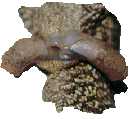Lizard Physical Examination
| This article is still under construction. |
Sexing
Gender identification in juvenile animals may be challenging; however, most lizard species display sexual dimorphism as adults.
- The most reliable method of determining gender is usually by comparing pore sizes. Indeed, adult male lizards tend to have large femoral and precloacal pores on the ventral aspect of the thighs; on the other hand, adult females have smaller, more discrete pores, similar to those seen in juvenile male lizards.
- Sexing probes (cloacal probing) can also be used in iguanas and monitors but aren't as consistently accurate as they are in snakes.
- Injecting saline solution (hydrostatic eversion) into the base of the tail in order to evert the hemipenis is another technique. However, care must be taken to avoid trauma to the hemipenis and prevent pressure necrosis. This method can be useful for species that are difficult to sex such as monitors, Tegus, large skinks, Beaded Lizards and Gila Monsters.
- Temporary eversion of the hemipenes in anaesthetized males can be done by applying gentle pressure at the base of the tail, just caudal to the cloaca.
- In some species, such as iguanas, the hemipenes in mature males will calcify and appear visible on radiographs.
- Endoscopy can be used to visualize gonads.
- Ultrasonic evaluation of the gonads or hemipenes is also possible.
Measurement
Carry out normal measurement procedures, such as rostrum to cloaca, cloaca to tail tip and weight.
